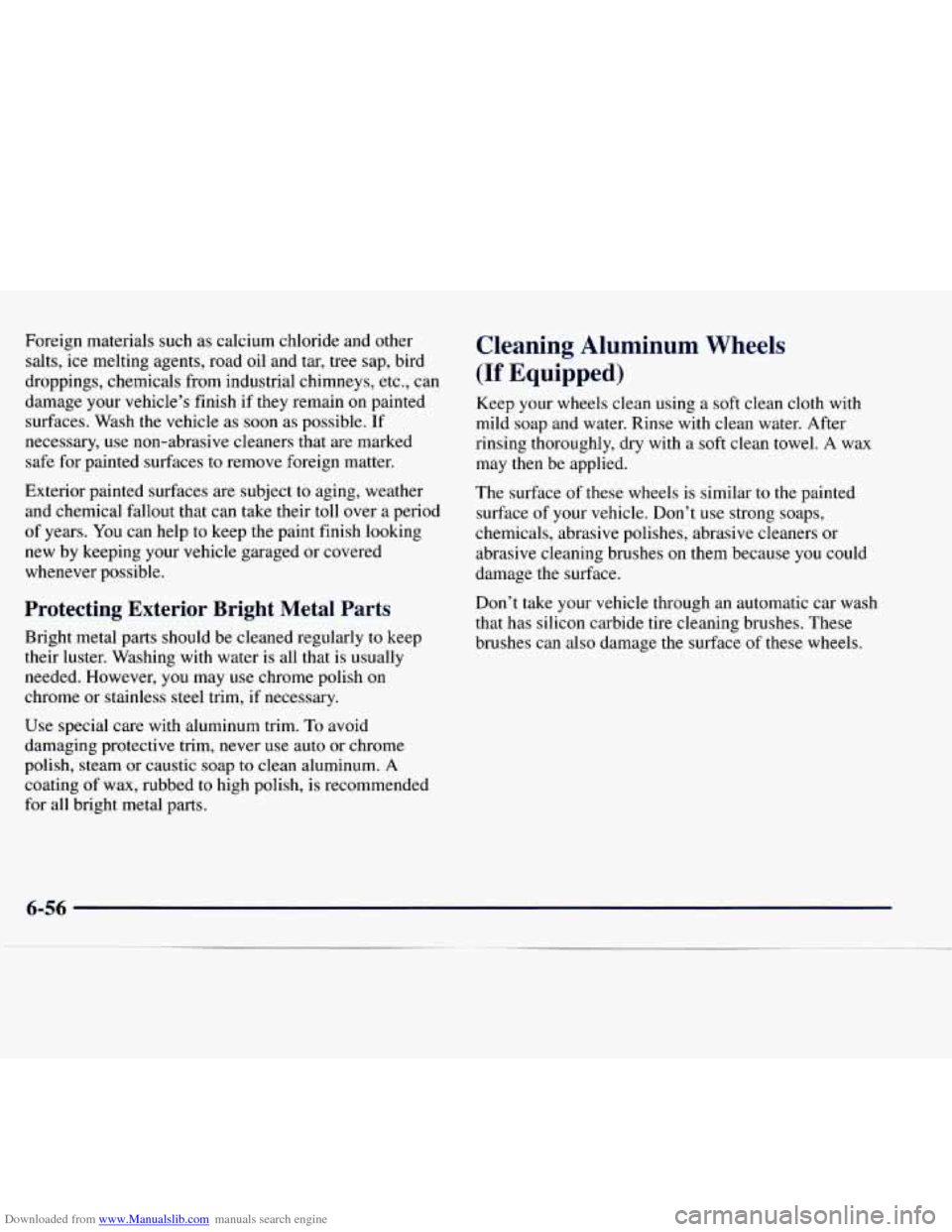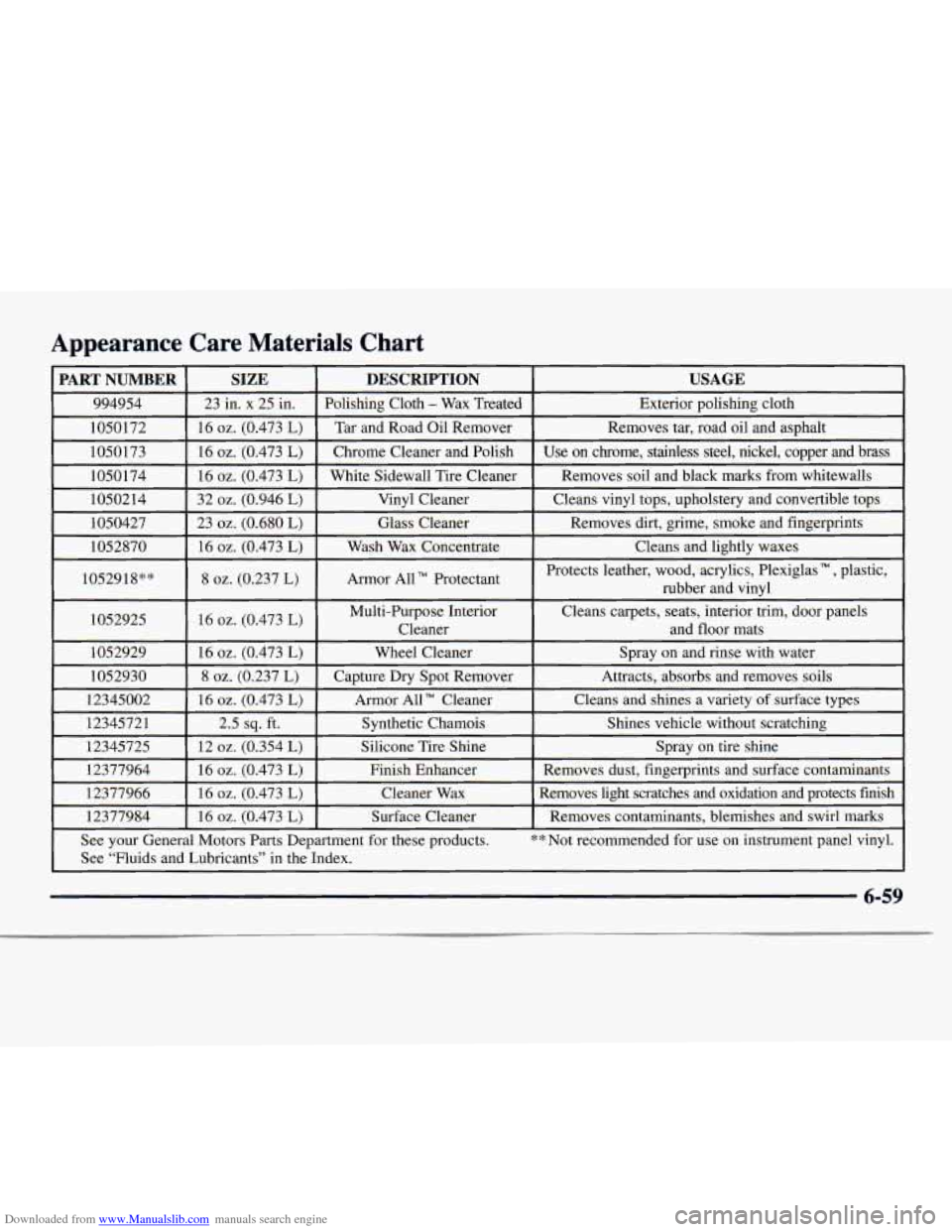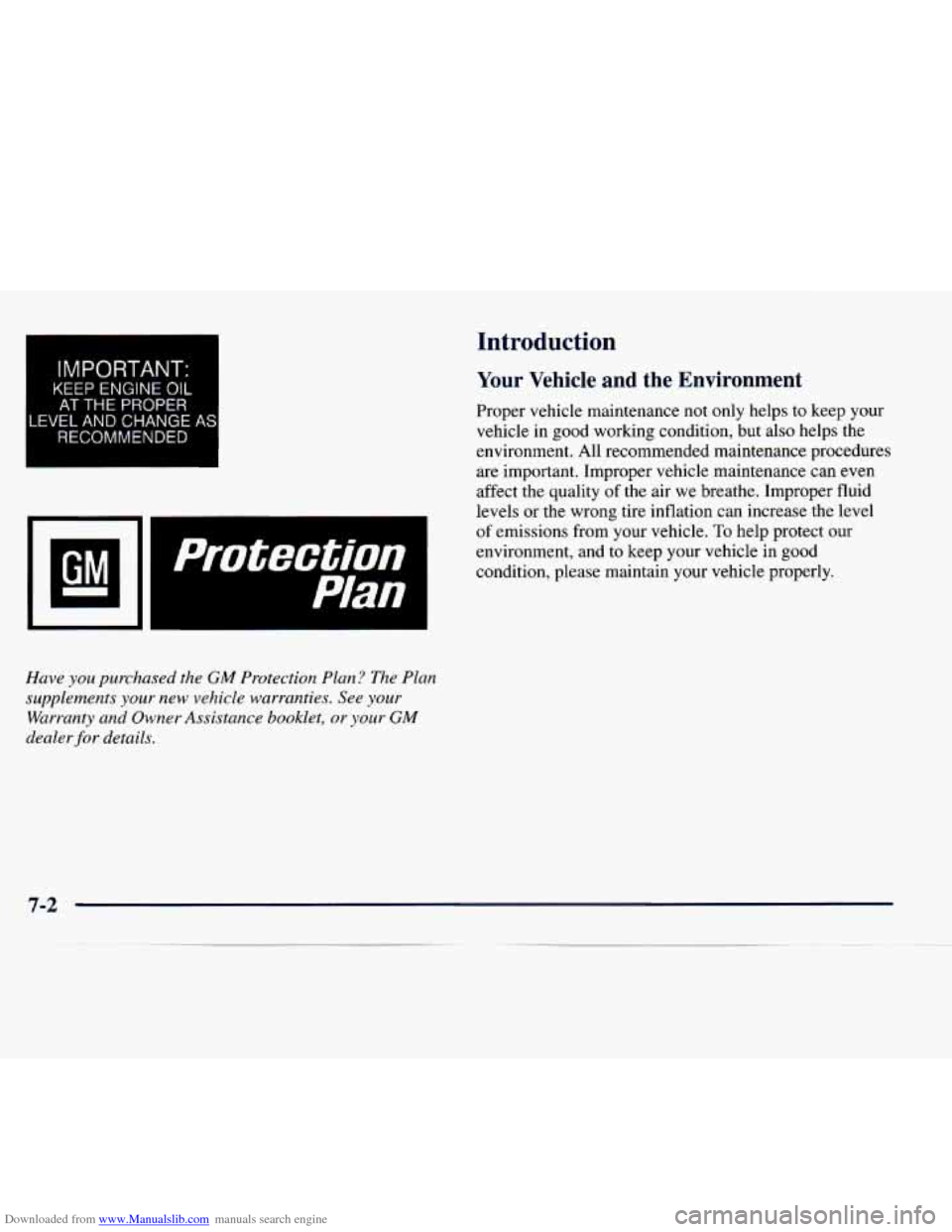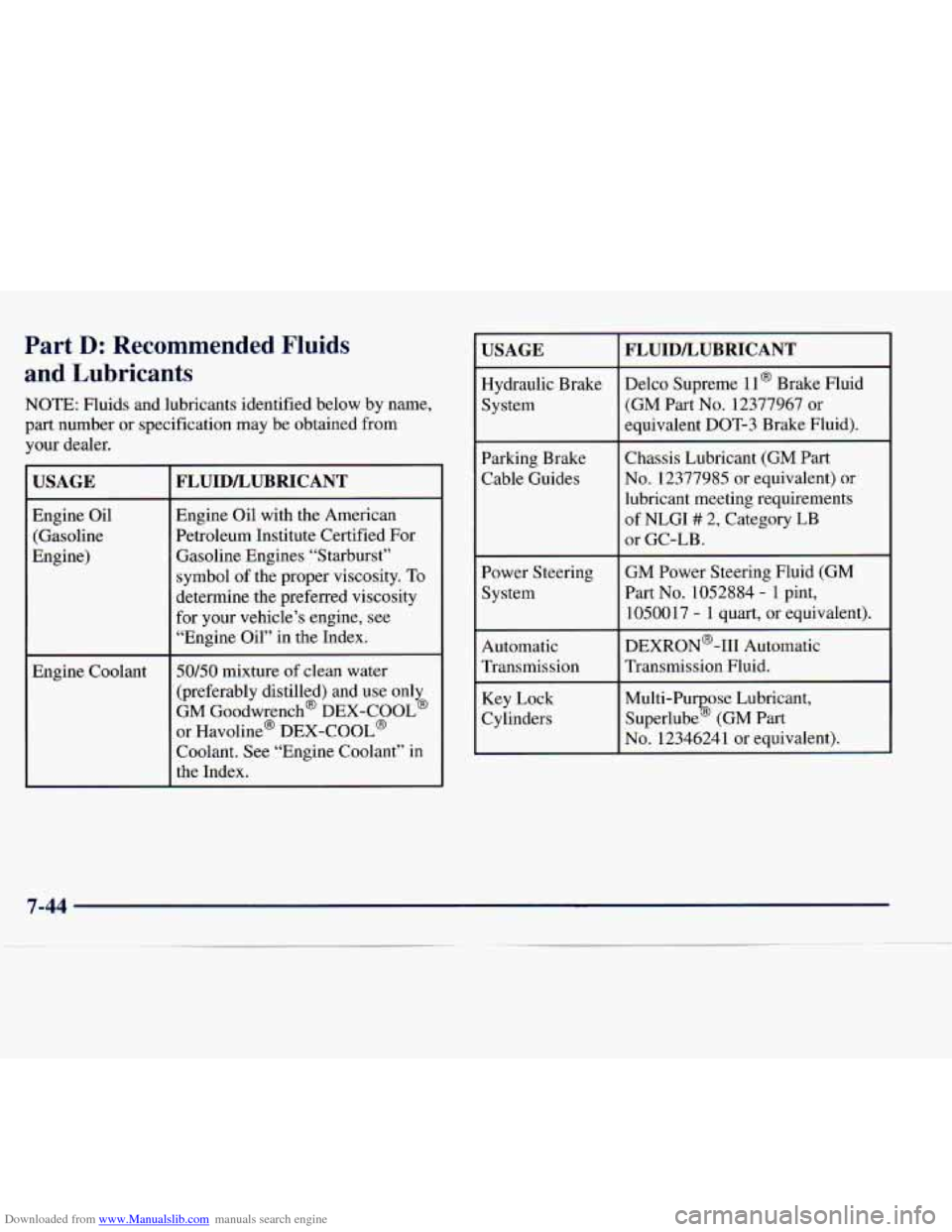1998 CHEVROLET EXPRESS recommended oil
[x] Cancel search: recommended oilPage 295 of 386

Downloaded from www.Manualslib.com manuals search engine Foreign materials such as calcium chloride and other
salts, ice melting agents, road oil and tar, tree sap, bird
droppings, chemicals from industrial chimneys, etc., can
damage your vehicle’s finish if they remain on painted
surfaces. Wash the vehicle as soon as possible. If
necessary,
use non-abrasive cleaners that are marked
safe for painted surfaces to remove foreign matter.
Exterior painted surfaces are subject to aging, weather
and chemical fallout that can take their toll over
a period
of years. You can help to keep the paint finish looking
new by keeping your vehicle garaged or covered
whenever possible.
Protecting Exterior Bright Metal Parts
Bright metal parts should be cleaned regularly to keep
their luster. Washing with water is all that is usually
needed. However, you may use chrome polish on
chrome or stainless steel trim, if necessary.
Use special care with aluminum trim.
To avoid
damaging protective trim, never use auto or chrome
polish, steam or caustic soap
to clean aluminum. A
coating of wax, rubbed to high polish, is recommended
for all bright metal parts.
Cleaning Aluminum Wheels
(If Equipped)
Keep your wheels clean using a soft clean cloth with
mild soap and water. Rinse with clean water. After
rinsing thoroughly, dry with a soft clean towel. A wax
may then be applied.
The surface
of these wheels is similar to the painted
surface of your vehicle. Don’t use strong soaps,
chemicals, abrasive polishes, abrasive cleaners or
abrasive cleaning brushes on them because you could
damage the surface.
Don’t take your vehicle through an automatic car wash
that has silicon carbide tire cleaning brushes. These
brushes can also damage the surface of these wheels.
Page 298 of 386

Downloaded from www.Manualslib.com manuals search engine Care Materials Chart
Appearance
PART NUMBER
994954
1050172
1050173 1050 174
10502
14
1050427
1052870
1052918**
1052925 1052929
1052930
12345002
12345721
12345725
12377964
12377966
12377984
SIZE
23 in. x 25 in.
16
oz. (0.473 L)
16 oz. (0.473 L)
16 02. (0.473 L)
32
02. (0.946 L)
23
oz. (0.680 L)
16 oz. (0.473 L)
8 oz. (0.237 L)
16 oz. (0.473 L)
16 oz. (0.473 L)
8 02. (0.237 L)
16 02. (0.473 L)
2.5 sq. ft.
12
oz. (0.354 L)
16 02. (0.473 L)
16 02. (0.473 L)
16 02. (0.473 L)
DESCRIPTION
Exterior polishing cloth
Polishing Cloth - Wax
Treated
USAGE
Tar and Road Oil Remover
Removes soil and black marks from whitewalls
White Sidewall Tire Cleaner Use on chrome, stainless steel, nickel, copper and brass Chrome\
Cleaner and Polish Removes
tar, road oil and asphalt
Vinyl Cleaner
Removes dirt, grime, smoke and fingerprints
Glass Cleaner Cleans
vinyl tops, upholstery and convertible tops
Wash Wax Concentrate Cleans
and lightly waxes
-
Armor All Protectant Protects
leather, wood, acrylics, Plexiglas N, plastic,
rubber and vinyl
..___
Multi-Purpose Interior
Cleans carpets, seats, interior trim, door panels
Cleaner and floor mats
Wheel Cleaner Spray on and rinse with water
Capture Dry Spot Remover
Attracts, absorbs and removes soils
Armor All Cleaner Cleans and shines
a
variety of surface types
Synthetic Chamois
Spray on tire shine
Silicone Tire Shine Shines vehicle
without scratching
Finish Enhancer
Removes light scratches and oxidation and protects finish
Cleaner
Wax Removes dust, fingerprints
and surface contaminants
Surface Cleaner Removes contaminants, blemishes and swirl marks
See your General Motors Parts Department for these products.
** Not recommended for use on instrument panel vinyl.
See “Fluids and Lubricants’’ in the Index.
6-59
Page 313 of 386

Downloaded from www.Manualslib.com manuals search engine I
IMPORTANT:
KEEP ENGINE OIL
AT THE PROPER
LEVEL AND CHANGE
RECOMMENDED
Introduction
Your Vehicle and the Environment
Proper vehicle maintenance not only helps to keep your
vehicle in good working condition, but also helps the
environment. All recommended maintenance procedures
are important. Improper vehicle maintenance can even
affect the quality of the air we breathe. Improper fluid
levels or the wrong tire inflation
can increase the level
of emissions from your vehicle. To help protect our
environment, and to keep your vehicle in good
condition, please maintain your vehicle properly.
Have you purchased the GM Protection Plan? The Plan
supplements
your new vehicle warranties. See your
Warranty and Owner Assistance booklet, or your
GM
dealer for details.
7-2
Page 319 of 386

Downloaded from www.Manualslib.com manuals search engine Short Trip/City Maintenance Schedule -- Gasoline Engines
The services shown in this schedule up to 100,000 miles
(166 000 km) should be performed after 100,000 miles
(166 000 km) at the same intervals. The services shown
at 150,000 miles (240
000 km) should be performed at
the same interval after 150,000 miles (240
000 km).
See “Owner Checks and Services” and “Periodic
Maintenance Inspections” following.
Footnotes
The U.S. Environmental Protection Agency or the
California Air Resources Board has determined that the
failure to perform this maintenance item will not nullify
the emission warranty or limit recall liability prior to the
completion of the vehicle’s useful life. We, however,
urge that all recommended maintenance services be
performed at the indicated intervals and the maintenance
be recorded.
# Lubricate the front suspension, kingpin bushings,
steering linkage and rear driveline center splines.
+ A good time to check your brakes is during tire
rotation. See “Brake System Inspection” under “Periodic
Maintenance Inspections” in
Part C of this schedule.
* * Drive axle service (see “Recommended Fluids and
Lubricants” in the Index for proper lubricant to use):
0
0
0
Locking Differential -- Drain fluid and refill at first
engine oil change. At subsequent oil changes, check
fluid level and add fluid as needed. If driving in
dusty areas or towing a trailer, drain fluid and refill
every 15,000 miles (25
000 km).
Standard Differential -- Check fluid level and add
fluid as needed at every oil change. If driving in
dusty areas
or towing a trailer, drain fluid and refill
every 15,000 miles
(25 000 km).
More frequent lubrication may be required for
heavy-duty use.
7-8
Page 338 of 386

Downloaded from www.Manualslib.com manuals search engine Long Tripmighway Maintenance Schedule -- Gasoline Engines
The services shown in this schedule up to 100,000 miles
( 166 000 km) should be performed after 100,000 miles
(166
000 km) at the same intervals. The services shown
at
150,000 miles (240 000 km) should be performed at
the same interval after
150,000 miles (240 000 km).
See “Owner Checks and Services” and “Periodic
Maintenance Inspections” following.
Footnotes
The U.S. Environmental Protection Agency or the
California Air Resources Board has determined that the
failure to perform this maintenance item will not nullify
the emission warranty or limit recall liability prior to
the
completion of the vehicle’s useful life. We, however,
urge that all recommended maintenance services
be
performed at the indicated intervals and the maintenance
be recorded.
## Lubricate the front suspension, kingpin bushings,
steering linkage and rear driveline center splines.
+ A good time to check your brakes is during tire
rotation. See “Brake System Inspection” under “Periodic
Maintenance Inspections” in Part
C of this schedule.
** Drive axle service (see “Recommended Fluids and
Lubricants” in the Index for proper lubricant to use):
0 Locking Differential -- Drain fluid and refill at first
engine oil change. At subsequent oil changes, check
fluid level and add fluid as needed.
fluid as needed at every engine oil change.
0 Standard Differential -- Check fluid level and add
7-27
Page 355 of 386

Downloaded from www.Manualslib.com manuals search engine Part D: Recommended Fluids
and Lubricants
NOTE: Fluids and lubricants identified below by name,
part number or specification may be obtained from
your dealer.
USAGE
Engine Oil
(Gasoline
Engine)
Engine Coolant
FLUIDLUBRICANT
Engine Oil with the American
Petroleum Institute Certified For Gasoline Engines “Starburst”
symbol of the proper viscosity. To
determine the preferred viscosity
for your vehicle’s engine, see
“Engine Oil” in the Index.
50/50 mixture of clean water
(preferably distilled) and use only
GM Goodwrench@ DEX-COOL@
or Havoline@ DEX-COOL@
Coolant. See “Engine Coolant”
in
the Index.
USAGE FLUIDLUBRICANT
Hydraulic Brake Delco Supreme 11 @ Brake Fluid
System
(GM Part No. 12377967 or
equivalent DOT-3 Brake Fluid).
Parking Brake Chassis Lubricant (GM Part
Cable Guides
No. 12377985 or equivalent) or
lubricant meeting requirements
of NLGI ## 2, Category LB
or GC-LB.
Power Steering GM
Power Steering Fluid
(GM
System Part No. 1052884 - 1 pint,
Automatic DEXRON@-I11
Automatic
Transmission Transmission
Fluid.
Key Lock Multi-Pu
ose Lubricant,
Cylinders Superlube
% (GM Part
1050017
- 1 quart, or equivalent).
No. 1234624 1 or equivalent).
7-44
Page 380 of 386

Downloaded from www.Manualslib.com manuals search engine Off-Road Recovery ............................. 4- 1 1
Oil. Engine .................................... 6-12
Overheating Engine
............................. 5- 1 1
Owner Checks and Services ....................... 7-38
Owner Publications. Ordering
................ 8- 1 1. 8- I2
Paint Spotting. Chemical
........................ 6-58
Park Automatic Transmission
....................... 2-21
Shifting Into
................................. 2-25
Shifting Out of
............................... 2-28
AtNight
.................................... 2-15
Brake ...................................... 2-24
BrakeMechanismCheck
....................... 7-41
Over Things That Burn
........................ 2-29
With a Trailer
................................ 4-36
Passenger Position
.............................. 1-26
Passing
................................... 4-11
Passlock
..................................... 2-16
Periodic Maintenance Inspections
.................. 7-42
Power
Antenna Mast Care
............................ 3-27
DoorLocks
................................... 2-5
Remote Control Mirror
........................ 2-45
Seat
......................................... 1-3
Steering
..................................... 4-8
Steering Fluid
................................ 6-25
Windows
................................... 2-31
Pregnancy. Use
of Safety Belts .................... 1-25
Parking
Lots
....................................... 2-16
8 *.
Problems on the Road ............................ 5-1
Publications. Service and Owner
.............. 8- 1 1. 8- 12
Radiator
..................................... 5-18
Radiator Pressure Cap ........................... 6-24
Radio Reception
................................ 3-23
Radios
.......................... 3-7.3-9.3-11. 3- 16
Rain. Driving In
................................ 4-15
Reading Lamps
................................ 2-43
Rear Axle
....................................... 6-21
Door Security Locks
........................... 2-5
Outside Seat Position
.......................... 1-34
Seatpassengers
.............................. 1-34
Towing
..................................... 5-11
Rear Air Conditioning and Rear Heater
............... 3-5
Rear Heater Controls (without Air Conditioning)
....... 3-4
Rear Passenger Temperature Control
................. 3-5
Rear Safety Belt Comfort Guides
.................. 1-37
Rearview Mirror
................................ 2-45
Reclining Front Seatbacks
......................... 1-3
Recommended Fluids and Lubricants
............... 7-44
Recovery Tank. Coolant
.......................... 5-16
Refrigerants. Air Conditioning
.................... 6-70
Remote Compact Disc Player
..................... 3-20
Replacement Bulbs
...................................... 6-66
Parts
....................................... 6-69
Wheel
...................................... 6-49
Replacing Safety
Belts ........................... 1-62
Reporting Safety Defects
.................... 8- 10. 8- 1 1
9-7